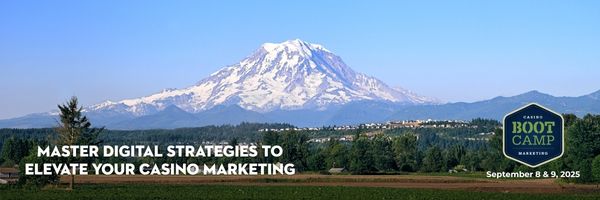Most casinos can tell you the ROI of their direct mail to the dollar. But ask the same operators whether their last promotion or digital campaign generated incremental revenue—and you’ll probably get silence.
Sounds familiar?
Casinos have a long history of effectively utilizing data, particularly for targeted offers and reinvestment. For decades, reinvestment analytics have influenced decisions on which players to invite back, how much free play to offer, and where to focus host attention. That work remains crucial, and most operators are comfortable trusting those insights.
But here’s the challenge: too often, analytics stop there. We’ve built muscle around reinvestment but leave other areas of marketing running on instinct, tradition, or “what we’ve always done.”
Just like a strong casino marketing plan provides structure for your efforts, analytics provide clarity on which tactics are worth the investment.
If you’re operating in a competitive regional market with tight budgets, that strategy leaves money on the table. It’s time to apply the same discipline we use in reinvestment to the rest of our marketing mix. Specifically, three areas stand out: advertising, promotions, and digital campaigns.
Advertising: From Gut Feel to Data-Driven Decisions
When I started my career in advertising, measurement was imprecise at best. You bought a radio spot or a print run, hoped it reached the right audience, and waited to see if visits increased. Success was measured in impressions, coupon codes or direct response phone numbers (bonus if you remember that), and gut feeling rather than detailed data.
Today, that guesswork has been eliminated. With OTT, programmatic buys, and even modernized traditional channels, we can identify who engaged, when, and—most importantly—whether they visited your casino.
Analytics can provide you with the cost per acquisition (CPA), conversion rates, and incremental visitation by channel. Here’s a real example: A $500 digital campaign reaches 20,000 people, drives 800 clicks, and generates 40 first-time visits. Your CAC? $12.50 per new guest. Compare that to a $1,200 legacy media buy that yields 30 trips at $40 each, and suddenly your media planning becomes a lot clearer. You can also use this approach when looking at legacy new member promotions, which we’ll address below.
Start with what you have: Most casino management systems can already track promotional codes and player card usage by campaign. You don’t need expensive attribution software—just discipline in tagging your campaigns and measuring beyond impressions.
Takeaway:
- Stop asking, “How many people saw this?” and start asking, “Who visited, and at what cost?” That’s how you stretch your budget and prove the ROI of your advertising.
- When speaking with media buyers or sales representatives, lead with your CAC goals: “We need to drive visits at under $15 each—show me how your platform delivers that.” This shifts conversations from rate cards to results.
- Use these metrics to justify budget requests to leadership: “Last quarter’s digital spend generated 400 visits at $12 CAC, while our benchmark shows competitors paying $25+ for similar results. We should increase this allocation.”
Promotions & Events – Measuring More Than Buzz
Promotions are often judged by the noise they create. The floor was packed, people were excited, and everyone had a good time. But did it pay off?
This is where analytics should step in. Tools like 28-day trending reports or layering reports help you compare redemption against incremental lift in visitation and spend. Two promotions may look equally busy, but only one actually grows profit.
Here’s what to track: For any promotion, measure baseline vs. promotional period across three metrics:
- Incremental visits: How many additional guests came during the promotion period?
- Average spend per visit: Did promotional guests spend more or less than typical?
- Net revenue impact: Total incremental revenue minus promotional costs and comps
A successful car giveaway might draw 2,000 people, but generate negative ROI if most visitors only play the minimum required amount. Meanwhile, a simple “double points Tuesday” could quietly deliver 150% ROI by encouraging existing players to visit an extra day each month.
Beyond the event itself, the real insights come from post-event analysis. Track guest behavior 30-90 days after your promotion. Did first-time visitors from your car giveaway return? Are they playing at higher levels than before? Sometimes a “break-even” promotion becomes profitable when you factor in the long-term value of newly acquired players.
Segment your results: Don’t just look at overall numbers; instead, examine the details. Break down performance by:
- Player tier (did you attract new players or shift existing play?)
- Day of week (Saturday night crowds vs. Tuesday afternoon results tell different stories)
- Geographic origin (are you drawing from your intended market or cannibalizing other properties?)
The comparison trap: Resist the urge to compare this year’s Valentine’s Day promotion only to last year’s, simply because they happened on the same holiday. Instead, compare promotional performance against similar investment levels, similar prize structures, or similar target audiences. This helps you understand what drives results versus what’s just a calendar coincidence.
Legacy daily promotions deserve special attention: Remember those new member promotions I mentioned in the advertising section? Many casinos continue running daily or weekly promotions simply because “that’s what we’ve always done” or because guests expect them. But analytics often reveal that these legacy programs have become expensive habit subsidies rather than growth drivers.
Take your typical “Monday Madness” slot tournament or “Win-Loss Wednesday” promotion. Sure, you get consistent participation, but are you attracting new players or just subsidizing the play of regulars who would visit anyway? Analytics can segment participants by visit frequency, average spend, and incremental behavior to show you the actual cost of these programs.
The goal isn’t necessarily to eliminate popular legacy promotions, but to optimize them. Perhaps your Monday tournament would benefit from smaller prizes but better food comps to attract new players. Maybe your drawing promotion should require play on underperforming machines rather than anywhere on the floor. Analytics help you keep promotions enjoyable and attractive while making them profitable again.
Takeaways:
- Don’t just measure turnout; measure profitability as well. Analytics tell you which promotions deserve to be repeated (or improved) and which should quietly disappear.
- Track the “promotion tail”—what happens 30-90 days later often determines true ROI, especially for new player acquisition events.
- When presenting results to leadership, lead with incremental revenue per dollar invested, not total attendance numbers.
Digital Campaigns – Proving What Moves Guests from Screens to Slots
Email, SMS, and social media campaigns are the darlings of modern marketing. The beauty of digital is that it’s trackable. Yet too often, we stop at vanity metrics. Open rates, likes, and shares make for nice dashboards, but they don’t tell you whether guests actually visited.
The real power lies in connecting digital engagement to on-property behavior. Did that SMS campaign bring in weekend play? Did your social ad drive visits, not just clicks? Did your email push guests to try a new restaurant?
Make the connection: Most email platforms can integrate with your player tracking system through UTM codes or unique offer codes. Track which digital touchpoints preceded actual visits within 7-14 days. You may find that your highest-engagement channels (such as social media) don’t correlate with your highest-conversion channels (like SMS or email).
Channel-specific insights: Different digital channels serve different purposes, and your analytics should reflect that:
- Email campaigns: Track not just opens and clicks, but redemption rates and average spend per redeemed offer. A 15% open rate that drives $50 average spend beats a 30% open rate with $20 spend. Additionally, because of how inbox service providers handle image-heavy emails (as casinos tend to use) and combined with the fact that typically guests don’t have to “bring” the email to access the offer, open rates can be low (and meaningless).
- SMS: Measure immediacy. How quickly do recipients act? SMS often drives same-day visits, making it perfect for last-minute inventory management (slow Tuesday nights, weather-impacted weekends).
- Social media: Focus on reach within your drive market, not total followers. One thousand local followers who actually visit are worth more than 10,000 distant fans who never will.
- Paid digital advertising: Track the whole funnel from impression to visit. A Facebook ad might get cheaper clicks than Google, but if Google visitors spend twice as much on average, your CAC calculation changes dramatically.
Timing and frequency: Analytics can reveal optimal send times and frequency caps that you’d never discover through engagement metrics alone. Perhaps your Thursday 2 PM emails get lower open rates but higher redemption rates because they reach people planning their weekend. Maybe your weekly SMS frequency is ideal, but daily texts decrease visitation as players tune out.
Don’t let booking friction kill your attribution: Here’s a conversion killer that most casinos overlook: the drop-off between digital engagement and actual booking. You send an excellently targeted email about your upcoming concert, track the clicks, see significant engagement, and then require people to call during business hours to reserve seats. How many potential guests clicked but never called? Your analytics will never capture that lost opportunity because the friction happens in the gap between digital and analog.
Consider your own behavior: when you come across an interesting event online, do you bookmark it to revisit later, or do you expect to book it immediately? Most people expect instant gratification, and requiring a phone call breaks that momentum. Even worse, it breaks your attribution tracking. You’ll never know how many people engaged with your digital campaign but abandoned due to booking friction.
The hidden cost: If your email drives 100 clicks to an event promotion but only generates 15 phone reservations, you might assume a 15% conversion rate. But what if 40 people intended to book but got frustrated with the phone requirement? Your actual conversion rate was actually 40%, and you’re missing 25 potential attendees due to process friction.
Modern solutions don’t require significant technology investments. Simple web forms, QR codes that link to booking pages, or even SMS-based RSVP systems can eliminate friction while preserving your attribution data. When people can book instantly after clicking your email, you’ll finally see the true performance of your digital campaigns.
Personalization beyond demographics: Utilize visit data to tailor digital campaigns to actual behavior, rather than relying solely on age and location. Recent slot players get different offers than table game regulars. Players who visit on weekday afternoons see different messaging than those on weekend nights. This behavioral segmentation often outperforms traditional demographic targeting.
Takeaways:
- Don’t settle for reporting engagement. Prove which digital channels move guests from screen to slot.
- Measure channel performance by cost per incremental visit, not cost per click or engagement rate.
- Use behavioral data from your floor to personalize digital campaigns. It’s more predictive than demographics alone.
- Present digital success in terms of leadership understands: “Our email program generated 200 incremental visits last month at $3.50 each, compared to radio’s $15 CAC.”
Your Analytics Action Plan
The good news? You don’t need to overhaul everything at once. Here’s how to begin applying analytics beyond reinvestment:
This Week: Choose one current campaign and set up proper tracking. Tag it with a unique identifier and commit to measuring both engagement and visitation.
This Month: Run a 28-day trending analysis and study your last three promotions. Which delivered the best incremental revenue per dollar spent?
This Quarter: Audit your digital channels. Which ones actually drive visits versus just engagement? Shift budget accordingly.
Common Mistakes to Avoid:
- Measuring activity instead of outcomes
- Forgetting to account for cannibalization (guests who would have visited anyway)
- Stopping measurement after the campaign ends (track 30-day lift)
What Good Looks Like
You’ll know your analytics efforts are working when you can confidently answer questions like:
- Which advertising channels deliver CAC under $20?
- Which promotions generate 200%+ ROI consistently?
- Which digital campaigns drive same-day vs. future visits?
These aren’t complex data science projects—they’re extensions of the reinvestment analysis you’re already doing well.
The Analytics Advantage Awaits
Reinvestment analytics will always be foundational, but they’re not the complete picture. While you’ve mastered measuring player reinvestment ROI, the same analytical rigor applied to advertising, promotions, and digital campaigns will give you a significant competitive edge.
The advantage isn’t just about better measurement but about better decisions. When you know which promotions truly drive incremental revenue, which advertising channels deliver the lowest CAC, and which digital campaigns move guests from screen to slot, you can outmaneuver competitors who are still flying blind.
Your competitors are already leveraging analytics to make more informed decisions about where to allocate their marketing dollars. The analytics advantage exists right now, waiting for you to claim it.
Start small. Pick one campaign or channel this month and measure it with the same discipline you apply to reinvestment. The insights will surprise you, and the competitive advantage will justify the effort.
These shifts in advertising analytics align with the evolving casino marketing strategies that today’s operators must embrace to stay competitive.




Recent Comments